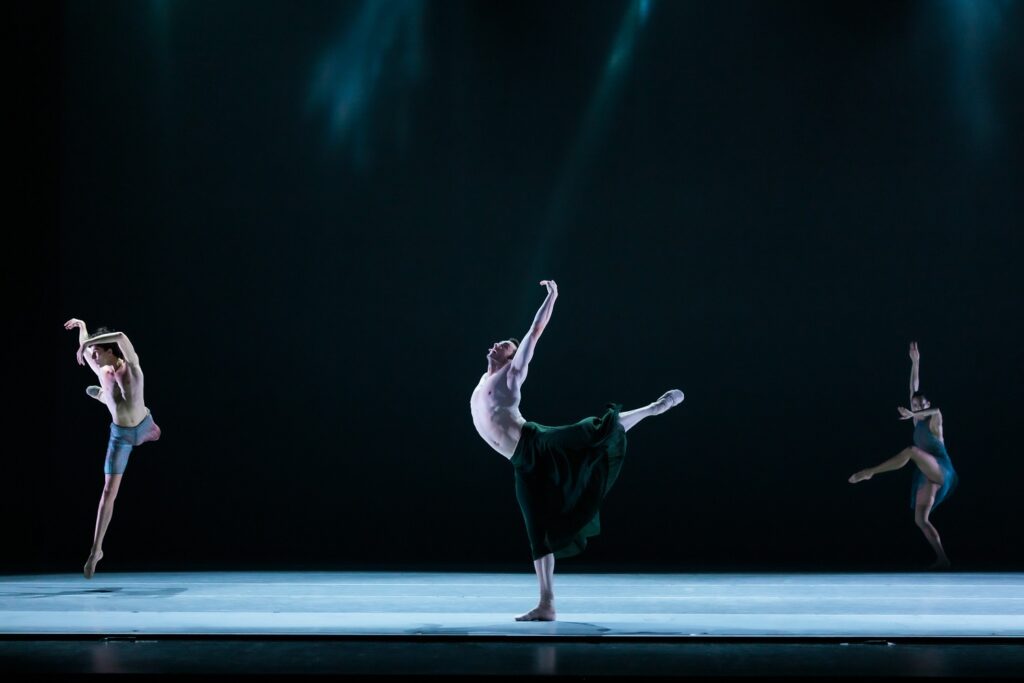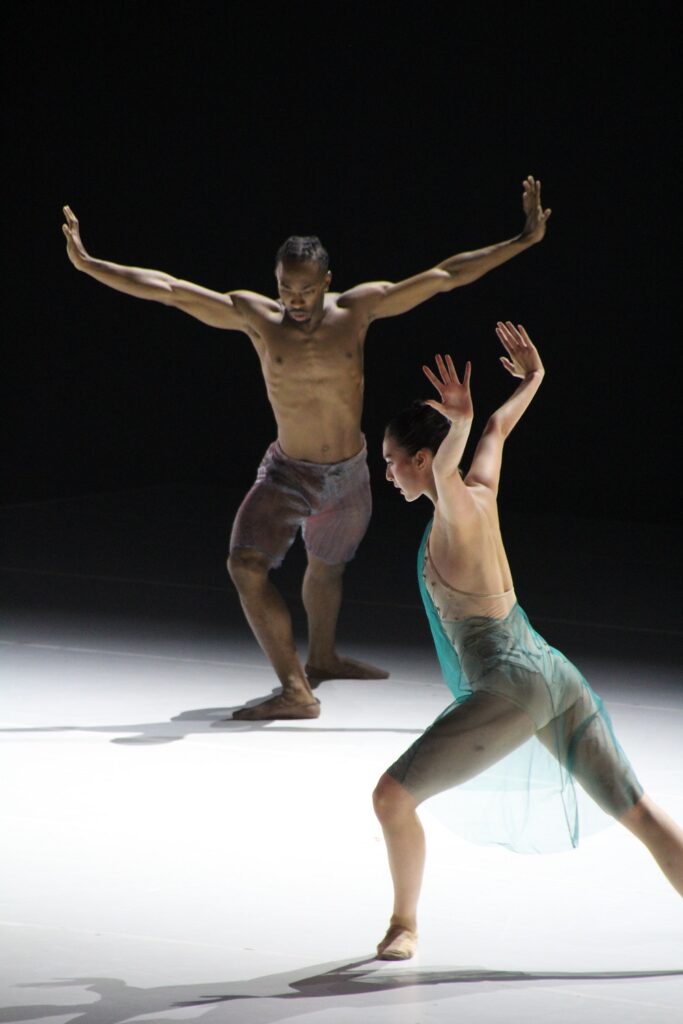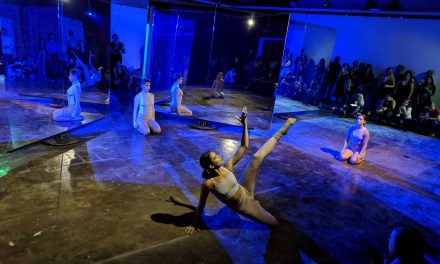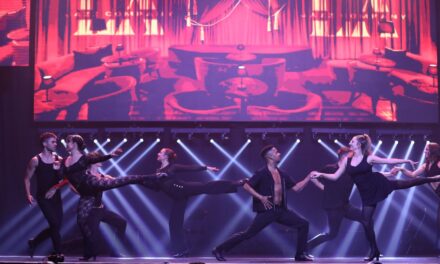On Saturday, November 8, 2025, at the Carpenter Performing Arts Center, I enjoyed a split bill presentation by Alonzo King Lines Ballet. Trekking down from Los Angeles to Long Beach was well worth it for a beautiful evening of dance presented by the esteemed contemporary ballet company. King’s signature distinct movement style shone through in both pieces, but the choreographic arrangements gave each piece its own flavor to match the different musical accompaniments.
Up first was “Ma Mère L’Oye” (Mother Goose) set to the music of Maurice Ravel. The dancers wore simple costumes in shades of yellow, green, and orange. While there were sections listed in the program, the whole thing blended together as dancers frequently entered and exited the stage to create different arrangements and layers. The movements featured strong balletic technique and angular shapes mixed with fluid movements. In both pieces, King’s movement vocabulary is strong. The dancers often jut or roll their hips to give more curve to their bodies. The dancers are long-limbed yet agile, quickly shifting from deep lunges into the highest leg extensions. Their arms wave fluidly like the wings of birds, and the range of motion emphasizes the dancers’ immense mobility as their arms extend behind their body. The way you might recognize frequent moments of plié, passé, or arabesque in a ballet performance, King’s vocabulary is consistent throughout: a unique language for his brand of contemporary ballet.
King’s partnering work was also enticing. Pairs would create shapes that would wind and unwind as they stayed connected. In one duet, Adji Cissiko showed off her infinite extensions in between promenades in uniquely connected counterbalances. At another moment, roles were swapped and Cissiko supported her partner in his own extension and rotated him via a connection point of linked elbows. The simple lighting was effective during these sections as we could see the shadows of the shapes rotating on the ground as they spun.
I loved that King is not afraid of brevity with his thoughts – in one moment during this first act, a smaller section ended, and the full company of 10 entered and stood in anticipatory stillness. A new piece of music began and the group burst into luscious phrases of movement for less than 10 seconds before breaking apart. Layers and dancers drifted in and out, matching the waves of the music, like a vivid garden of strange creatures. At the same time, things were not always just flowing. King found moments of syncopation, stillness, and suspense to contrast the beautiful fluidity of the movements and their arrangements.
While things were constantly shifting, I felt a slow build as the dancers gathered and stayed onstage towards the end of the piece. The layers became more complex and never stayed the same for long. At times there would be three or four phrases happening at once: two solos in front of two lines doing their own phrase-work. The shared language made it so that phrases complemented each other with balance.

Alonzo King LINES Ballet – Theo Duff Grant with Mael Amanda Amatoul and Amanda Smith in “Ode to Alice Coltrane” – Photo ©Chris Hardy.
The second piece, “Ode to Alice Coltrane” was set to Alice Coltrane’s music, ranging from more familiar jazz to her Eastern-influenced spiritual jazz. The piece began more starkly than the first. Four dancers knelt in a hallway of light and began to progress across the stage with crawls and quick reactive actions, as if they were responding to hearing the music. This section featured more clear repetition as we were drawn into the piece. There seemed to be a journey depicted as the dancers mostly traveled across the stage in one direction. Even as things layered and complexified later, I still felt this general directionality. In addition to the continued use of subtle, simple shifts in lighting, there were some projections onto the cyc that created a feel of being underwater with distorted rays of lights emanating from the top of the screen. The costumes had simple silhouettes and were made of sheer green, brown, and black fabrics. Sometimes the lighting seemed to change the color of the costumes due to their sheerness, making the dancers seem like color-changing chameleons.
The movement vocabulary was a continuation of the first piece, but instead of feeling like effervescent creatures, the dancers exuded jazzy cool. The layers of the choreography often clearly mimicked the different instruments. Especially compelling were the solo moments where a dancer was able to move with the informed abandon of a jazz musician improvising. It felt like there was just the right level of indulgence and showiness as we saw the individual dancers have a chance to show off impressive turns and extensions.
The dancers effectively matched the layers of the music, both the coolness of the jazz and later the yearning spiritual invocations. They also frequently highlighted the plucks of the harp in how their movements initiated, making it a true tribute to Alice Coltrane and her instrument of choice.
The evening was truly a splendid display of artistry and musicality. King’s small company of dancers are at the height of their field. King takes the structure of ballet and riffs off that, pushing the extremes of movement and letting his dancers shine as individuals. If I were to pause a particular moment, it is likely that no two dancers would be in the same exact position, but the detail to the impulse and intention give it a shared, living, breathing energy that is phenomenal to bear witness to.
Lighting Designer: Seah Johnson; Costume design: Robert Rosenwasser.
To learn more about Alonzo King Lines Ballet, please visit their website.
For more information about the Carpenter Performing Arts Center, please visit their website.
Written by Rachel Turner for LA Dance Chronicle.
Featured image: Alonzo King LINES Ballet – Photo by Nicholas Neira.








